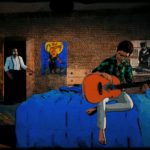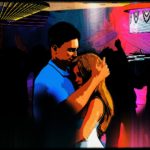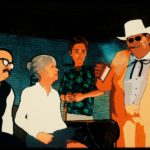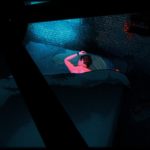Canción de Verano para una Chica de la Playa
Fille de la plage
- Technical Info / Información Técnica:
(2022) / 00:08:08 / 4K / 3840×2160 / Motion Cómic / Software: DAZ 3D Studio, After Effects / 30 fps / 16:9 / Color / Sound: Stereo / Argentina / animation short film, portrait
- Logline:
During the summer break, a lonely teenage musician falls madly in love with an unknown girl while at the beach, leading him accidentally to fame within the music industry, and later to a decadent success.
Durante las vacaciones de verano, un solitario cantautor adolescente se enamora perdidamente de una desconocida chica en la playa, lo cual lo llevará accidentalmente hacia la fama en la industria de la música, y posteriormente hacia un éxito decadente.
- Director´s Biography / Biografía del Director:
NICOLÁS MONTES
Graduate in Visual Storytelling, as well as a degree in TV Production, Nicolas Montes works mainly as a 3D Artist whose career path was largely forged in advertising and in the video game industry. Works also in various branches of post-production, such as color grading and compositing, in both film and TV.
Licenciado en Comunicación Audiovisual y graduado de tecnicatura de Producción y Realizador Televisivo, oficia como Animador 3D, cuya trayectoria profesional fue forjada mayormente en la publicidad y en la industria de los videojuegos. También trabajo en diversas ramas de la post-producción, como colorista y compositor, en cine y TV.
- Director’s Statement / Declaraciones del Director:
The project is based on a story originally published in the prestigious anthology publication Metal Hurlant. My main interest remained in telling a story with a beginning, middle, and an end – along with characterized protagonists – mostly with images pictorial in nature, supported by the bare minimum of words as possible, in a quasi-telegraphic way. In other words; create narrative meaning of the combination of images supported by a few words, these allusive and complimentary, but never descriptive of what is seen on the screen. There are multiple theoretical influences regarding the narrative. On the one hand, the most elementary is the Kuleshov effect; Although it is a theory of montage rather than one of visual compositing, the notion persists that the result of the juxtaposition of two images is more narratively effective than the isolated images, as well as the text. Another of my intentions was to apply the narrative theory of the comic-book medium to the cinematic language and give depth to the image as well. The language of the ninth art is the result of the fusion of the linguistic code, that is, of the graphemes, with the iconic code being images. Parallels can be drawn between the Kuleshov effect and the fundaments of Will Eisner and Scott McCloud, in which they stipulated that the language of the graphic novel is based on the transmission of a story through the combination of words and images. According to these authors, in some way, the interest in each of these components is inversely proportional to the interest in the other. In the comic, the word and the image build meaning together so they cannot be separated from each other. Scott McCloud describes how the reader unconsciously fills in the spaces between vignettes to establish continuity and reconstruct the story and especially the movement; otherwise, a comic would be nothing more than a series of disjointed and fragmented images. The space that separates two vignettes of a comic is known as gutter (or visual ellipsis) and it is there where the reader fills in the gaps through the closed; this being the point of contact between the comic-book narrative and one of film, or rather, between the comic book narrative and Kuleshov’s postulate. Regarding the graphic style, this mainly is based on the tradition of classic animation, with particular emphasis on the work of Ralph Bakshi. The intention in replicating this art style consists of making the backgrounds mimic the look of an oil painting, and the figures being flat colored.
El proyecto está basado en una historia originalmente publicada en la prestigiosa publicación antológica Metal Hurlant. Mi principal interés fue en narrar una historia con un principio, desarrollo y desenlace -con personajes delineados mediante – mayormente con imágenes pictóricas sustentadas por la menor cantidad de palabras posibles, de un modo cuasi telegráfico. Dicho de otro modo; crear sentido de la combinación de imágenes apoyadas por escasas palabras, alusivas y complementarias, pero no descriptivas a lo que se ve en pantalla. Las influencias teóricas en cuanto a la narrativo son varias. Por un lado, la más elemental, el efecto Kuleshov; si bien es una teoría de montaje más que de la composición visual, persiste la noción de que el resultado de la yuxtaposición de dos imágenes es más efectivo narrativamente que las imágenes en sí mismas, amén del texto. Otra de mis intenciones fue aplicar la teoría narrativa propia del cómic a lo audiovisual, además de darle profundidad a la imagen. El lenguaje del cómic es el resultado de la fusión del código lingüístico, es decir de los grafemas, con el código icónico (imágenes). Se pueden trazar paralelos entre el efecto Kuleshov y los planteos de Will Eisner y Scott McCloud, en los cuales estipularon que el lenguaje del cómic se basa en la transmisión de una historia mediante la combinación de palabras e imágenes. Según estos autores, de alguna manera, el interés por cada uno de dichos componentes es inversamente proporcional al interés por el otro. En el cómic, la palabra y la imagen construyen el sentido juntas por lo que no pueden separarse la una de la otra. Scott McCloud describe cómo el lector rellena inconscientemente los espacios entre viñetas para establecer una continuidad y reconstruir la historia y sobre todo el movimiento, pues de lo contrario un cómic no sería más que una serie de imágenes inconexas y fragmentadas. El espacio que separa dos viñetas de un cómic se conoce como gutter (o elipsis visual) y es allí donde el lector rellena los huecos a través del cerrado, este es el punto de contacto entre el comic y el cine o, mejor dicho, entre la narrativa de cómic y el postulado de Kuleshov. En cuanto al estilo gráfico, este está principalmente la tradición de la animación clásica, haciendo énfasis en particular en la obra de Ralph Bakshi, la intención en replicar dicho semblante consistió en realizar los fondos imitando el aspecto de una pintura al óleo y las figuras con un relleno de color plano.
- Overview / Ficha técnica:
Script / Guión: Nicolás Montes
Producer / Producción: Nicolás Montes
Director / Director: Nicolás Montes
Animation Direction / Dirección de Animación: Nicolás Montes
Art Director / Dirección de Arte: Nicolás Montes
Voice: Jordan Elsass
Basado en la obra escrita por Jean-Luc Fromental e ilustrada por Philippe Berthet
- Festivals and Awards / Festivales, Premios y Nominaciones:
– 23 BAFICI, Buenos Aires Int Independent Film Festival; 04/2022; Argentina
- Links:
Trailer: https://vimeo.com/586901135
https://www.facebook.com/Nicolas.L.Montes/
- Contact / Contacto:
Gisela Chicolino
FilmsToFestivals Distribution Agency









